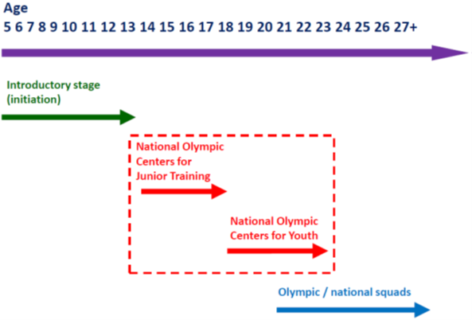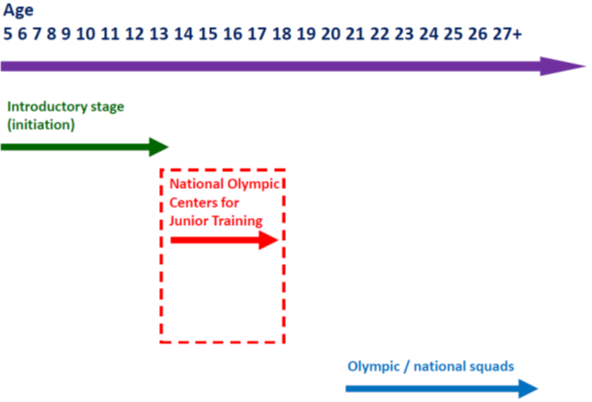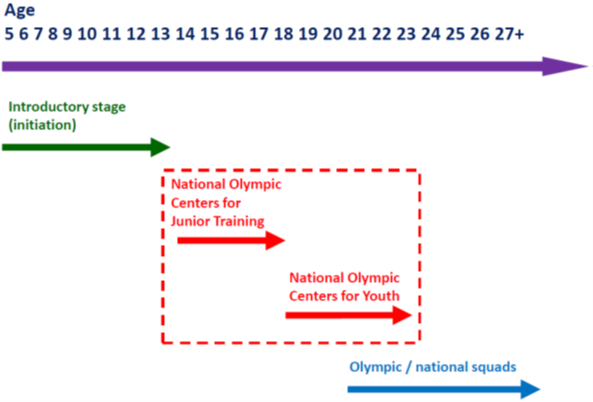
Improving the athletes’ development pathway – NOC Romania model
Florin Mișcă – Romania
For my MEMOS project (NB: I am a MEMOS VII graduate) I chosed a theme related to the main task I had at that time within NOC Romania, namely the programme “National Olympic Centers for Junior Training” (NOCJT). The title of the project was “Diagnosis and perspectives for NOC Romania programmes for young high level athletes”).
This programme, dedicated to young athletes aged between 14 and 18 years, was implemented in Romanian sports in 1979. Shortly after its implementation, it determined an impetus for the entire activity of selection and training of juniors. It was also found that the Romanian Olympic Teams were made up of over 90% of athletes who, during their junior years, had trained in these Centers. Thus, it became a strategic programme of NOC Romania and the basic link in our athletes’ pathway to Olympics.
The MEMOS project was just the beginning. The elaboration of the project helped me to better understand our system, the context and the arguments that determined the adoption of some decisions and the implementation of some programmes, their evolution and the transformations they went through and the factors that influenced their dynamics. Also, I began to better understand what are the relevant indicators to evaluate, to measure the effectiveness of such a sports programme, in the context of Romanian sports and Romanian society at that time.
Shortly after graduating MEMOS, I advanced in the NOC Romania hierarchy, becoming the director of the sports department. This gave me the opportunity to adapt the data recording system that followed the dynamics of the programme’s efficiency indicators, according to the ideas gained from participating in MEMOS.
Although the results obtained by Romanian athletes at the Beijing 2008 Olympics and the London 2012 Olympics, indicated a decrease in the performance of our athlete development system, I found that I still do not have enough data to formulate and propose an improvement.
Furthermore, the system, as it was, was considered functional, the relevant indicator taken into account being that, further on, the Olympic Teams were made up of a very high percentage of athletes who had “passed” through NOCJT.
Also, the data from the records of NOC Romania did not indicate errors in the organization and functioning of NOCJT.
It was very clear for me that I needed also other types of data to indicate with certainty where the problem is and what solutions could be proposed.
Thus, in 2014, when I became deputy secretary general of NOC Romania, I initiated a study that included a theoretical study of the issue of athletes’ development and the role of sports organisations in this process, studying some models of athletes’ development in the specialised literature (pyramid model, Bloom’s model, Istvan Balyi’s LTAD model, Jean Côté’s model and the model proposed by Chelladurai and Madella) and athletes’ development models from countries in the top of the world rankings, as well as the application of a questionnaire to all national sports federations from the NOC Romania General Assembly. The questions focused on the factors identified in the literature, based on the bibliographic study and were grouped into ten parts: 1) introductory questions; 2) governance, communication, policies and strategies; 3) the training process of athletes; 4) support offered to athletes; 5) sports facilities; 6) coaches; 7) national and international competitions; 8) scientific research; 9) measures to improve the training system for high performance athletes; 10) questions that led to a SWOT analysis.
The results of the study were complex, showing and objectifying a multitude of aspects of the training system for elite athletes in Romania.
The dynamics of the Romanian society since 1990 and implicitly of the sports field, had determined a series of significant and obvious changes both in terms of human resources involved and in terms of allocated resources and especially changes in the place and role of performance sports in society and relationships. between the stakeholders.
Legislative changes have led to changes in the organization of National Sports Federations (NSF) and especially in the way they could obtain funding from the State (NB: the significant part of the NSFs budget).
The federations were trapped in a very well-defined trap by Juan Carlos Tedesco, a noted Argentine educator who said “…our societies and rulers claim that the urgency of problems impedes thinking about long-term problems, whilst in reality, it is the absence of long term perspectives that makes us slaves of urgency.” (International Forum on Elite Sport, September 11-13, 2001, Centro de Alto Rendimiento, Sant Cugat: 40).
Thus, the concerns of reorganization, adaptation to legislation, continuing to support the activities derived from their own Statute and from the duties determined by the affiliation to the European and International Federations, corroborated with the insufficiency of human resources, as well as their high fluctuation, determined a decrease of attention and concern for the training of athletes after “leaving” the NOCJT, respectively after the age of 18 years.
Thus, the accumulations from the training period in NOCJT (age 14-18 years) were not fully exploited in the next stage, when the financing and control of NOC Romania disappeared.
Thus, based on the results of the study, I proposed to the secretary general at that time the idea of implementing a programme to extend the financing and control of NOC Romania in the process of athletes’development, in the preparation stage over the age of 18 years.
This was followed by a long series of consultations with the National Sports Federations to identify the optimal model for organizing and operating this programme (age range, benefits allocated to athletes, selection and promotion criteria, participation in national and international competitions etc.).
This resulted in a programme dedicated to athletes in the age category 18 – 23 years (taking into account also the international sports calendars that included many Under 21 and Under 23 competitions) focused on the main determinant and conditional factors of sports performance and adapted to the needs of this age, from all points of view, including social and educational (NOC Romania pays tuition fees for athletes to continue their studies).
The programme harmonizes the needs of sports performance with the educational needs in the athletes’ development, taking into account the recommendations of the XIII Olympic Congress, Copenhagen, 2009: “All constituents of the Olympic Movement should endorse the importance of combining education and sport. Priority should be given to the development of programmes aimed at building athletes’ lifetime skills. The Olympic Movement in collaboration with parents, coaches and members of the athletes’ entourage should encourage and promote the participation of athletes in their career programmes, during their competitive years as well as after their retirement from high-level competition. This will enable them to combine education and sport seamlessly through dual careers.”
The programme is named “National Olympic Centers for Youth” (NOCY).
After the approval of the Executive Committee, on September 9th, 2014, the implementation of the programme began, which involved intense collaboration with the administration of the federations and clubs in the territory. The selection, budgeting and administrative procedures took almost a year. By mid-2015, more than 100 athletes were already included in the program.
At this time the program includes over 200 athletes.
The positive effects of the programme began to appear. The best, the most obvious example, for us, is the Romanian Rowing Federation, which managed to raise a generation of athletes who went through NOCJT and later through NOCY, now being medalists at European Championships and World Championships and considered by specialists with chances to win medals at the Tokyo Olympics.
Athletes’ development pathway before 2015:
Athletes’ development pathway since 2015:
Have questions or want to know more? Contact Florin Misca here!


